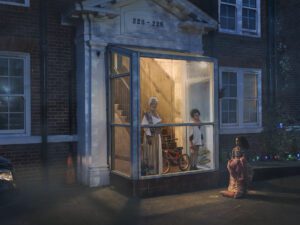Jasmina Cibic explores the notion of “soft power”, asking how political structure subtly dictate and interfere with social attitudes and the artist’s reflective visuals. Ahead of a panel discussion at the 2018 Future Now Symposium – alongside Noemi Varga, Phoebe Roberts (Artangel), Gideon Koppel (Manchester Metropolitan University) and Alessandro Vincentelli (BALTIC) – Cibic discusses how artists’ film has become a standalone genre.
A: How would you categorise the evolution of moving image and why do you work in this medium?
JC: Coming from a performance and installation background, delving into moving image occurred quite naturally. At heart of my practice lies the study of protocol and government architecture with its recalling of panopticons, the creation of carefully studied viewing platforms and power and movement control of its users. As such I began using such architectures that speak of statecraft strategies as cinematographic devices within which I place choreographic movements and rhetorical engagement.
A: Video and moving image adopt the same principles to photography – the resulting visuals are believed to be a reflection on real life, and thus a form of truth. How do you think this suggestion has aided the progression of moving image and its purpose today?
JC: I am specifically interested in manifesting the synergies of various archival traces of history within a medium that lends itself closest to a total art form – as such the moving image has the capacity of creating immersive experiences which transcend many pragmatic production issues art faces today – especially with its unequal production levels globally. International Biennials apart, we can rarely expect art institutions from countries facing economic crisis to put on vast installation environments and live art. Video and moving image do provide a more democratic distribution ground, which is seminal with works that speak precisely of political and societal inequality, distribution of cultural capital and geo-political exotic.
A: How do you respond to the notion that audiences are increasingly needing instant gratification, and therefore, artists need to think more about narrative?
JC: The perception of time is being exponentially altered and as such follows the alteration of our perception of experience. However, artistic practices have throughout history provided propositions of different ways of seeing and experiencing our reality. Personally I feel diverse artistic practices answer back to contemporaneity in different ways – for some it makes perfect conceptual sense to reassert the current valid and expected conditions from their audience, whereas for some – it makes more sense to pose parallel realities contradicting what is expected.
A: When creating films, how important is new technology? How has your practice altered over time and how is this exemplified in your work?
JC: I tend to choose technical aspects pragmatically and there are seldom works where we need to make concessions due to technology. However I am working on a new project for DHC/ART Montreal where we are looking at a compromise solution between stenographic and props trickstery and a very demanded technical solution. In the end it’s a question of budgets – which unfortunately always remain the bitter reality of artist moving image and video works.
A: Your work has been shortlisted for the Aesthetica Art Prize in 2017 and you’ve recently had a show at BALTIC. How do you think prizes help the career of artists today?
JC: I do not work with galleries, so the publicising of my projects is central to my practice and it immensely contributes to the flow of running the studio as well as to new funding possibilities for my upcoming projects. Awards such as the MAC International Ulster Bank Award, Charlottenborg Fonden Award and the Arts Council grants have made a large contribution to my work being able to tackle larger ideas and expand the contributors I collaborate with.
My current exhibition at BALTIC Centre for Contemporary Art is a product of amazing collaboration with some fantastic institutions and their curators – the Museum of Contemporary Art Zagreb, Kunstmuseen Krefeld and of course BALTIC. I have worked with the curator Alessandro Vincentelli intensely – dissecting the project and finding the correct permutation for its presentation, the outcome of which I am very proud of.
A: What has been your biggest achievement to date?
JC: Being able to work on the essence of what I hold as most fragile within our political reality – that is how are we as cultural producers implicit in the re-ignition of cultural capital and its inequalities.
Jasmina Cibic is at BALTIC Centre for Contemporary, Gateshead, runs until 28 May. Click here.
Artists’ Film: The Evolution of Moving Image runs 17 May, 14:45-16:00.
The Future Now Symposium runs 17-18 May at York St John University. For more information, or to book your pass, click here.
Credits:
1. Courtesy of Jasmina Cibic.
Join the Conversation. Follow us on Instagram, Twitter, Facebook and Pinterest.




